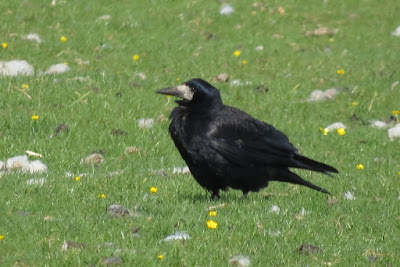21st May to 11th June: Tony & Ann Taylor and Richard & Rebecca Taylor visited the Old Light
Manx Shearwater colony six times, ringing 98 new birds and retrapping 41 different birds from previous years. Eleven of these were originally ringed as chicks, in 2007 (1), 2010 (1), 2012 (3), and 2013 (6). Numbers seemed high at the Old Light colony, so there were no immediate signs that last winter's El Niño has affected the population. However, the weights of birds with downy brood patches, assumed to be pre-breeders, were lower than on previous May/June visits, so they may be in poorer condition than usual. It will be interesting to see what the return rate of 'the class of 2015' is when they are due to come back in the next two or three years.
21st to 23rd June: Helen Booker and Mark Bolton, looking for evidence of breeding by
Storm Petrels, set up CCTV cameras viewing a relatively small area at the Old Light shearwater colony. The cameras picked up at least two petrels. Helen reports there may well have been more but the infrared glare from whatever was flying past, and the difficulty in judging distance, made identification quite a challenge – a close flying moth may look very like a bird slightly further away with no other real perspective available! Scanning with torches at the North Light, they picked up petrels fluttering through the beam regularly over a period of 15 minutes – a sign that birds are breeding and a good place for further monitoring to determine numbers of breeding pairs. Scanning with torches along the quarry boulders on the East Side and above Pilot's Quay, however, revealed no birds.
21st to 28th June: David & Elisabeth Price, Peter Slader and Lee Bullingham-Taylor spent most of their daytime activities visiting virtually all the sites for cliff-nesting birds, checking, reviewing and taking photographs to update the Site Register ready for next year's census of breeding seabirds. Scrambling down to assess most of the viewing points proved a very useful exercise in more ways than one. They found that
Guillemots are increasingly occupying areas higher up the cliffs, often in the broken ground immediately below the sidings (where previously they would probably have been vulnerable to rats).
Puffins too are moving in and colonising similar sorts of areas at a fast rate.
On the shearwater front, the problem was a rather bright moon and a series of mainly clear cloudless nights, with just one suitable cloudy night (26th) when it had rained most of the day but was still overcast and misty (and incredibly wet underfoot!). The team erected one mist-net in the Old Light colony at 11:00 and within a few minutes there was a “
small thing in the bottom shelf” – a
Storm Petrel! Bare skin on the brood-patch area indicated that this was probably a breeding bird. The team called it a night at 02:00 by which time a total of 21
Manx Shearwaters had been caught. Two turned out to be well-travelled birds ringed 2004 and 2006.
Apart from the obvious burgeoning population of Puffins, it seemed that
Guillemots had spread everywhere. Whereas 15 years ago they were very much restricted to the inaccessible ledges on vertical faces, they are now scattered all over the cliffs, and particularly in the bouldery edges just below the sidings. There were even
Guillemots on Devil's Chimney. The last recorded occupancy was in 1986, whereas in 1939 Richard Perry recorded some 400 on the stack.
In terms of numbers, the 234 individual
Puffins counted were all on land, with a further 30-50 out on the sea nearby at any time. The figure of 2,678
Guillemots is truly phenomenal – almost double the number recorded in Jenny's Cove in 2013, and more than the total recorded in any surveys prior to 2008 for the whole island. The increased numbers of breeding seabirds was certainly a big fillip for the trip, and though the team fell short of their objectives on the ringing front, they definitely achieved their prime objective – to have a good time!













































